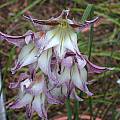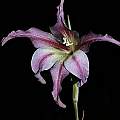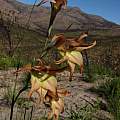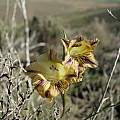Winter rain Gladiolus like their winters wet and mild and may need a dry summer dormancy. They are often less hardy, reaching down to USDA zone 8 at most.
Page 1: G. abbreviatus... Page 2: G. brevifolius... Page 3: G. carneus... Page 4: G. deserticola... Page 5: G. grandiflorus... Page 7: G. marlothii... Page 8: G. mutabilis... Page 9: G. pulcherrimus... Page 10: G. saccatus... Page 11: G. teretifolius...
Gladiolus inflexus Goldblatt & J.C.Manning is endemic to only a few places in the Southwestern Cape where it grows in sandstone derived gravel. Growing from 20 to 35 cm, it has 1 to 3 purple flowers formed on a wiry bent stem. The sweetly scented flowers have a strongly arched dorsal tepal and a large lower median tepal that is greater than the lower laterals. The bases of the tepals and the throat are cream with the lower tepals speckled to blotched purple. Flowering time is mid to late July, sometimes into August. The first photo was taken by Rachel Saunders. The next three were taken by Alan Horstmann.
The next three photos from iNaturalist were taken by Douglas Euston-Brown in July near Worcester and shared under a CC BY-SA license.
Gladiolus insolens Goldblatt & J.C.Manning grows in a few wet sites along streams and seeps in rocky areas on the higher slopes of the Piketberg in the western Cape. It has a spike of one to three bright scarlet flowers and five to seven narrow grey green leaves. Height range: 30-50 cm. Photo by Rachel Saunders.
Gladiolus involutus D.Delaroche is found on clay slopes in renosterveld and grassland in areas with summer and winter rainfall. Flowering from winter into spring, it has white flowers with yellow-green markings on the lower tepals. Height: 30-50 cm. Photo by Bob Werra.
Gladiolus kamiesbergensis G.J.Lewis grows in rocky sites in shrubby fynbos in the Kamiesberg of central Namaqualand. From 45-90 cm tall, this species has small, pale, lilac flowers with minute purple dots within and on the reverse of the tepals. The lower lateral tepals are yellow on the lower half of the limbs. This species flowers in spring and the flowers are sweetly scented and probably pollinated by long-tongued bees. Photos taken by Andrew Harvie.
Gladiolus karooicus Goldblatt & J.C.Manning was named in 2009. It is found from the Little Karoo to the Komsberg section of the Roggeveld Escarpment. Photos taken September 2011 by Cameron McMaster near Matjiesfontein.
Gladiolus leptosiphon F. Bolus is an uncommon species from South Africa that occurs from Ladismith in the Little Karoo to Uitenhage in the Eastern Cape where it is found on stony hills and low mountain slopes in renosterveld or arid fynbos. It is threatened by ongoing habitat loss to agricultural expansion, particularly ostrich farming but also crop cultivation. Plants grow up to 60 cm tall with narrow whip like leaves and 6-9 creamy white flowers marked with dark red-purple lines on the lower three tepals and a long slender tube. The upper three tepals are largest, the dorsal suberect and the lower tepals narrow, channeled, arching downward. Flowering is in spring (October to November). Pollination is by a long-tongued fly. Photos from the book Plants of the Klein Karoo courtesy of Jan and Anne Lise Schutte-Vlok.
Gladiolus liliaceus Houtt. grows on clay slopes over a wide area of South Africa (from the Cedarberg Mountains to Port Elizabeth) and blooms winter to spring. Growing from 30 to 80 cm high, the 1 to 4, sometimes 6, flowers are an inclined spike. The large flowers are brown, dull pinkish red, tan, purplish or cream to greenish yellow and turn bluish to mauve in the evenings when they become intensely clove scented. Depending on the location and the elevation with the lower elevations blooming earlier, this species blooms from late August to December.
The ones grown by Mary Sue Ittner have not been very fragrant and the color change is subtle. Photo 1 was taken by Mary Sue Ittner. Photos 2-3 from Bob Rutemoeller attempt to show the change in color. Photo 2 was taken during the day and photo 3 in the early evening. Andrew Harvie's photos (4-5) show the orangey red color of the day and the more purple color of the night. To ensure correct color balance both photos were taken with a flash and same exposure. He notes that he wishes he could also share the fragrance.
The forms pictured below in the first four photos were all found at Drayton and were blooming August-September 2003. Photos by Bob Rutemoeller including a single yellow one. The fifth photo is of a red flowered one photographed by Cameron McMaster near Bredasdorp in the Overberg. The last photo from the book Plants of the Klein Karoo courtesy of Jan and Anne Lise Schutte-Vlok.
Gladiolus maculatus Sweet extends across the southern coast and immediate interior of the winter rainfall area to the Eastern Cape where it is often found growing in heavy soils in renosterveld. Flowers are dull yellow to lilac and speckled with brown or purplish spots. They are long-tubed and fragrant during the day and the evening. Height range: 30-60 cm. The first three pictures were taken by Cameron McMaster near Napier and Bredasdorp in the Overberg.
The first two pictures below are of garden flowers taken by Mary Sue Ittner December 2007 and January 2009. The next two were taken by Alan Horstmann and the last by Dirk Wallace.
Page 1: G. abbreviatus... Page 2: G. brevifolius... Page 3: G. carneus... Page 4: G. deserticola... Page 5: G. grandiflorus... Page 7: G. marlothii... Page 8: G. mutabilis... Page 9: G. pulcherrimus... Page 10: G. saccatus... Page 11: G. teretifolius...


































